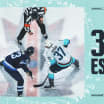The standings are typically presented by division grouped by Western Conference and Eastern Conference.
WESTERN CONFERENCE
The Pacific Division includes the Kraken, of course, plus Vegas, three California teams (LA Kings, Anaheim Ducks, San Jose Sharks) and trio of western Canada entries (Vancouver, Calgary and Edmonton).
The Central Division features Colorado, St. Louis, Chicago, Dallas, Nashville, Minnesota, Winnipeg and, starting this season, Arizona, to make room for the Kraken joining the Pacific.
EASTERN CONFERENCE
The Metropolitan Division includes Washington, all three New York area teams (Rangers, Islanders and New Jersey Devils), Philadelphia, Pittsburgh, Carolina and Columbus. For Seattleites who hoped the 32nd franchise would be called the Metropolitans, this division name is one reason why NHL commissioner Gary Bettman didn't like the idea.
The Atlantic division features back-to-back Cup-winning Tampa Bay, plus Boston, Montreal, Toronto, Florida, Ottawa, Buffalo and Detroit. That adds up to 16 teams in the East and another 16 in our West.



















